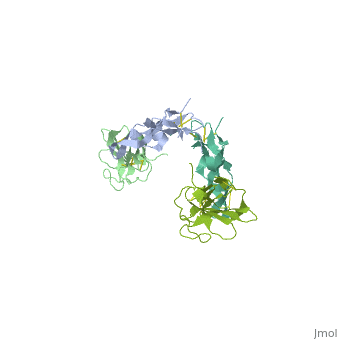TGF-beta receptor
From Proteopedia
(Difference between revisions)
| Line 19: | Line 19: | ||
</StructureSection> | </StructureSection> | ||
| - | == 3D Structures of TGF-β receptor== | ||
| - | |||
| - | Updated on {{REVISIONDAY2}}-{{MONTHNAME|{{REVISIONMONTH}}}}-{{REVISIONYEAR}} | ||
| - | {{#tree:id=OrganizedByTopic|openlevels=0| | ||
| - | |||
| - | * TGF-β receptor I; Domains: extracellular 33-112; kinase 200-503 | ||
| - | |||
| - | **[[1ias]], [[5e8s]] – hTGFBR-I kinase domain – human <br /> | ||
| - | **[[5e8t]], [[5e8u]] – hTGFBR-I kinase domain (mutant) <br /> | ||
| - | **[[5e8w]], [[5e8x]] – hTGFBR-I kinase domain (mutant) + staurosporine<br /> | ||
| - | **[[2l5s]] – hTGFBR-I extracellular domain - NMR<br /> | ||
| - | **[[1b6c]] – hTGFBR-I kinase domain + FKBP12 <br /> | ||
| - | **[[1py5]], [[3faa]], [[3gxl]], [[3hmm]], [[2wot]], [[2wou]], [[3kcf]], [[2x7o]], [[3tzm]], [[4x0m]], [[4x2j]], [[4x2k]], [[4x2n]], [[5qim]], [[5fri]], [[4x2g]], [[4x2f]] – hTGFBR-I kinase domain + inhibitor <br /> | ||
| - | **[[5e8z]], [[5qik]], [[5qil]], [[5qtz]], [[5qu0]], [[6b8y]], [[5e90]] – hTGFBR-I kinase domain (mutant) + inhibitor<br /> | ||
| - | **[[1vjy]] – hTGFBR-I residues 1-303 + inhibitor <br /> | ||
| - | **[[5usq]] – hTGFBR-I residues 123-421 + inhibitor <br /> | ||
| - | **[[1rw8]] – hTGFBR-I truncated kinase domain + inhibitor <br /> | ||
| - | **[[6mac]] – hTGFBR-I extracellular domain + GDF-11 + activin receptor 2B- <br /> | ||
| - | |||
| - | * TGF-β receptor II | ||
| - | |||
| - | **[[1m9z]] – hTGFBR-II extracellular domain <br /> | ||
| - | **[[1plo]], [[4p7u]] – hTGFBR-II extracellular domain (mutant) - NMR<br /> | ||
| - | **[[4xjj]] – hTGFBR-II extracellular domain (mutant) + inhibitor<br /> | ||
| - | **[[5e8v]] – hTGFBR-II kinase domain (mutant) <br /> | ||
| - | **[[5e8y]] – hTGFBR-II kinase domain (mutant) + staurosporine<br /> | ||
| - | **[[5e92]] – hTGFBR-II kinase domain (mutant) + AMPPNP<br /> | ||
| - | **[[5qin]], [[5e91]] – hTGFBR-II kinase domain + inhibitor <br /> | ||
| - | **[[1ktz]] – hTGFBR-II extracellular domain + TGF-β3 <br /> | ||
| - | **[[5ty4]] – hTGFBR-II extracellular domain + mmTGF-β2 <br /> | ||
| - | **[[5tx4]] – mTGFBR-II extracellular domain (mutant) + hTGF-β2 - mouse<br /> | ||
| - | **[[1ks6]] – cTGFBR-II extracellular domain - chicken<br /> | ||
| - | |||
| - | * TGF-β receptor III | ||
| - | |||
| - | **[[3qw9]] – TGFBR-III ZP-C domain - rat<br /> | ||
| - | **[[4ajv]] – mTGFBR-III ZP-C domain <br /> | ||
| - | |||
| - | * TGF-β receptor I+II | ||
| - | |||
| - | **[[2pjy]] – hTGFBR-I extracellular domain (mutant) + hTGFBR-II extracellular domain (mutant) + TGF-β3 <br /> | ||
| - | **[[3kfd]] – hTGFBR-I extracellular domain + hTGFBR-II extracellular domain + TGF-β1 <br /> | ||
| - | }} | ||
== References == | == References == | ||
<references/> | <references/> | ||
[[Category:Topic Page]] | [[Category:Topic Page]] | ||
Revision as of 11:21, 16 February 2020
| |||||||||||
References
- ↑ Wrana JL. TGF-beta receptors and signalling mechanisms. Miner Electrolyte Metab. 1998;24(2-3):120-30. PMID:9525694
- ↑ Frischmeyer-Guerrerio PA, Guerrerio AL, Oswald G, Chichester K, Myers L, Halushka MK, Oliva-Hemker M, Wood RA, Dietz HC. TGFbeta receptor mutations impose a strong predisposition for human allergic disease. Sci Transl Med. 2013 Jul 24;5(195):195ra94. doi: 10.1126/scitranslmed.3006448. PMID:23884466 doi:http://dx.doi.org/10.1126/scitranslmed.3006448

